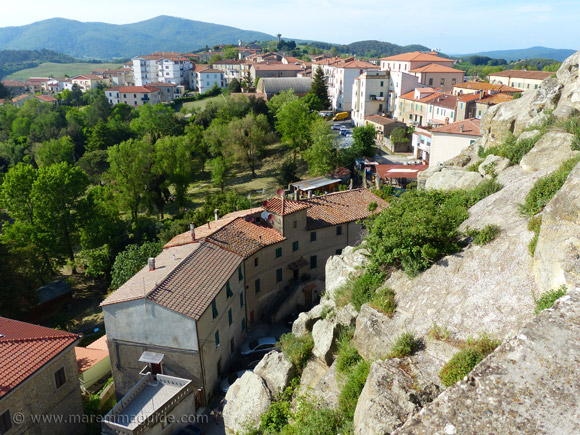Roccastrada Tuscany Italy
When first impressions don't count in Maremma
Roccastrada Tuscany Italy. There is an English saying that, "clothes maketh the man", but in the case of Roccastrada it isn't true.
Driving into Roccastrada for the first time is like one of those occasions when you briefly meet someone new and form a first impression that leaves you not at all interested in them. At times you pass them at some distance in the street without bothering to make the gesture of crossing over and saying, "hello". And any brief subsequent encounters only go to confirm your original impressions.
But then, one day, you happen to properly meet them and the experience blows your assumptions out of the water leaving you smiling and not wanting to wait to see them again.
I'd like to introduce you to Roccastrada in Maremma, whose external facade hides a fascinating character.
 The view if you look up as you enter the historic centre of Roccastrada along Via della Balzina.
The view if you look up as you enter the historic centre of Roccastrada along Via della Balzina.
So why were my first impressions of Roccastrada so wrong?
My only saving grace in having mis-judged it is that my very first encounter was late one night on the way home from Firenze. We were tired and hungry. It was dark and my excuse is that I didn't look up and see the historic centre above me as we drove into the centre of town, concentrating as I was on finding an osteria or restaurant open. We parked in the centre and walked around. Found a restaurant, but they couldn't take us. So, back in the car, we headed home. First impressions: a typical rural Italian town with nothing special to see.
Since then and until last weekend in early May, I have driven past many times and seen the town from a distance from Sassofortino and Sticciano, but never bothered to visit. On this particular Sunday however, I had time free to go out with my camera and Roccastrada was the only place on my map of Maremma within a short drive that I hadn't explored, ever. So off I set, expecting not to meet "anyone" special. Oh, boy...
This time I spotted the medieval cobbled road into the historic centre - Via della Balzina - and walked up it.
When you get to the first acute bend in the medieval road, you will see this hazard sign and barrier because an old pedestrian route into town under the palazzo building is no longer accessible: it doesn't stop the local children playing there though!

Walk to the top where the road opens into a small piazza, home to the thirteenth century church of San Nicola, and look behind you and you will have this wonderful view to another of Maremma's medieval hill towns, Civitella Marittima. Just follow the dead-straight - must be a Roman - road to it.

Once inside Roccastrada's city gates and ancient walls you will find one narrow fascinating medieval street after another. Nothing prettified or dressed for tourists, just plain simple everyday rural Italy and all the more engaging for it.
 Porta di Borgo
Porta di Borgo
I find the testimony of centuries of incredible history that a cut-in-half archway here, or a stone-filled ancient window there are waiting to tell those who want to see and know almost intoxicating: I sometimes get giddy not knowing what to look at or photograph first in Maremma as there is so much to see. And then as fascinations go, I love old Tuscan doors...
The buildings and streets in Roccastrada in Maremma have a lot to tell and a lot of doors.
Looking down Vicolo del Podesta.

And up from one of its windowsills.

Black cats in Italy are meant to bring bad luck, but in the UK where I grew-up black cats are meant to bring good luck and I when I was a little girl I had a jet black cat just like this stunning one.
Talking of cats... Just past the clock tower on the way down into the newer part of town there is a palazzo that is covered in a vine. Outside of it, no more than a few feet away at most, you will find a grey stripy cat the size of a dog! He isn't just a bit "cicciona" (chubby), but is a bulldog build cat. Take it from me that "sweet-talking"him to get him to pose doesn't work: he is a very indifferent cat.
 A dream of a balcony
A dream of a balconyThen don't be surprised if you see a cat of similar size, albeit not quite so large, sat in the back window of a car as it drives in to park outside the front door of the palazzo. It is the equally robust twin brother, who prefers to accompany the male member of the household out into the countryside for the day, returning in the evening as "happy as Larry". The two greet each other with nose to nose "kisses" as their - much smaller and slimmer - mother comes out of the house to greet him too :)
 The washing hanging out back above the alley.
The washing hanging out back above the alley.
 Can you spot the cat?
Can you spot the cat?
A little of a lot of Roccastrada history
Roccastrada's surviving recorded history - sat upon its rhyolite platform in the centre of Maremma with its natural defensive advantage - first appears in documents of the tenth century as belonging to the Signori di Lattaia. A Sienese family with its roots in Monteleone who had their own castle, the Castello di Lattaia, which is now a farm, the Fattoria di Lattaia, nearby.

But its history goes way back beyond then. For its surrounding land is home to many tunnels that were excavated by the Etruscans to extract silver and copper.
In 1140, the castle and its occupants formed part of the territory - along with San Quirico, San Casciano and probably San Filippo, of Pope Innocenzo II (when he was Pope, for this man's reign as Pope was anything but secure and for part of it he fled to Pisa and France when he was declared anti-Pope!).

In 1274, with the division of the Aldobrandeschi family rule into two branches - the county of Sovana with Ildebrandino il Rosso di Pitigliano, and the county of Santa Fiora with Ildebrandino di Bonifico - Roccastrada became the property of the latter.
At the end of the thirteenth century the city opened its doors to may Ghibellini exiles which, as far as the Republic of Siena was concerned constituted just motive for war. The conquest of Roccastrada was concluded in 1301 and by diplomatic channels.

But in 1315, a rebellion by the Counts of Santa Fiora was quelled by the City of Siena by use of battering rams: the castle fell again and was demolished. With its second conquest, Siena took control also of the metalliferous hills around and their silver and copper mines: a rich reward.
From that moment on, Roccastrada remained the property of Siena until, as with most of Maremma's cities and towns, it became part of the "Stato granducale", the Duchy of Tuscany.
The Torre dell'Orologio - The Clock Tower

The Torre dell' Orologio dates from the fourteenth century and was the fulcrum of Roccastrada's fortification, protecting access from the north of the castle, whilst the Porta del Madonnino protected entrance from the south. But the one you see today isn't the original: it was irrevocably damaged during the Second World War and rebuilt in the same style and proportions, including its original crown of hanging arches which you will also find, albeit much more elaborate, in Siena's the Torre del Mangia.
The view of the rock that Roccastrada was built on in the tenth century from down below in town is impressive: the walls at the top that you can see is the Terrazza dei Mille.


The parish church - Chiesa di San Nicola
Roccastrada's parish church is the Chiesa di San Nicola - also known as the Chiesa di San Nicolò - was in all likelihood built at the same time as Roccastrada's castle.
The earliest records of the church go back to 1275 and 1276. An inscription with the date of 1283 - that once was in the architrave above the door and is now in the housed in the sacristy - that mentions one "Brunaccio" builder, probably refers to one of the first restorations and expansions of the church.
Of interest inside are two frescoes - the "Madonna col Bambino", and "L'Annunciazione di Maria" - both of which are attributed to a mid-sixteenth century painter from the workshop of Domenico Ghirlandaio in nearby Col di Val d'Elsa, one Giovanni Maria di Ser Giovanni Tolosani.

The Madonna col Bambino was originally in the Chiesa delle Carceri - Roccastrada's prison church. Whereas the L'Annunciazione came from the Chiesa della Compagnia della Santissima Annunziata, which was demolished in 1929.
If you just happen to be a fan of Giovanni Maria di Ser Giovanni Tolosani's work, then you can see more in Roccastrada's other church the Chiesa delle Madonna delle Grazie in Via del Convento, originally part of the convent, Convento del Carmine. There are two more frescoes.
The first, the the "Cristo in pieta tra i dolenti", can be found in the sacristy and is dated from between 1435 and 1439 - the last number on the inscription is missing to tell for sure which year.
In all probability the fragments of the "Madonna con Bambino" that you can see on the left-hand side inside the church is his too.

 When the sun is out in Maremma nothing escapes the spring-clean!
When the sun is out in Maremma nothing escapes the spring-clean!
Don't miss
Climb higher-up into the "cassero" and take a walk down the entire length of Via Contessa Giovanna - it gets narrow in places - turn left to the dead-end and then back-track to go down some steps and up along Via Aldobrandeschi to reach its end at the panoramic view-point
 Via Contessa Giovanna
Via Contessa GiovannaThe panoramic view point of Maremma's colline metallifere is around the corner of an old building - you will probably find a handful of old ladies sat on its steps chatting away the afternoon - to the left of the buildings in this photograph.
If you haven't got your own binoculars with you - you don't need them to enjoy the spectacle - the view point has its own coin operated public viewer.
 Via Aldobrandeschi
Via Aldobrandeschi
And the view is wonderful: the tiny hamlet of Sticciano in the distance sat on the top of one of the Monte Leoni foothills, covered in a cloak of green.

Then walk a few steps around the corner to the Terrazza dei Mille - the Terrace of a Thousand - for a birds-eye view over the roof-tops of Roccastrada and where you will find a plaque to mark the birth of Ranieri Tonissi.
At just 17 years of age, and one of just 78 men in the whole of Tuscany, Ranieri Tonissi volunteered as one of Giuseppe Garibaldi's "red shirts" and joined the "Spedizione dei Mille" - the Expedition of the Thousand - 1,162 men who embarked at Quarto in Genova over the night of 5-6 May 1860 in two ships (the Il Piedmont and the Il Lombardo) from the Port of Genova.
He was born
on 30 August 1842, and until that day had lived in a house on the "Rocca". (The house was demolished after the landslide in the town in 1969.)

"La Partenza del garibaldino", by Gerolamo Induno, 1860. Attribution: Fondazione Cariplo.
The "mille" volunteers were armed with only old rifles and were devoid of ammunition and gunpowder: supplies that had been agreed to be delivered by boat by Piedmontese supporters to the ships after they had left Genova had mysteriously and controversially failed to arrive.
Garibaldi had to arm his men before battling troops that well outnumbered them and decided to dock on 7 May 1860 in the port of Talamone in Maremma, where he obtained reinforcements and arms from the Army of the Kingdom of Sardinia. And then again, further down Maremma's coast, in Porto Santo Stefano for coal and drinking water.
The redshirts landed at Marsala in Sicily on the 11 May 1860, where they took control of the port: a pivotal point in Italy's unification history.
Tonissi returned to Grosseto where he worked as a bartender and then saddler, and died in 1893 at only 51 years of age: his grave remains untraced.
The distinctive and curved Palazzo Bersotti dates dates back to the middle of the eighteenth century and is home to many frescoes of its own. Its two wings and double flight staircase were later additions. If you get the chance to see inside, one room in particular has a painted ceiling in the neoclassical style.
 Palazzo Bersotti with modern-day Roccastrada in Tuscany behind it.
Palazzo Bersotti with modern-day Roccastrada in Tuscany behind it.


Museo della vite e del vino - Roccastrada's museum of vine and wine
You'll find the Museo della vite e del vino in Piazza dell'Orologio, on the ground floor of the building adjacent to the clock tower. The rooms were originally a "cantina (cellar) carved out of the bedrock upon Roccastrada sits.
Opening times at the moment are Saturdays from 10:00 to 13:00, and 16:00 to 20:00, and Sundays from 10:00 to 13:00.
Entry is free. Call 0564 563376 for information.


Roccastrada's Potato festival - the Sagre della Patata
Around the last weekend in July - from a Friday to a Sunday night - the whole town is out for the "Sagra della Patata" - three nights of home-cooking all based upon the potato with a live band one night, a disco on the Saturday night, and then an orchestra on the Sunday playing in Piazza Garibaldi (next to the Clock Tower).
You can check on the Maremma Events page for the exact dates and times each year.

Roccastrada real estate
A rural Tuscany home in an historic building is possible in Roccastrada as there are there are plenty of places for sale in the medieval centre, restored or in need lotsand lots of loving attention.
For sale in this photograph is a cellar and store room.

The best accommodation in Roccastrada
For the Tuscany experience of our dreams, sleep in this restored eleventh century monastery and estate in Maremma that is nothing less than superb. Memories are made of places like this.
Choose from suites or apartments with four poster beds - and breakfast delivered if you want it :) - huge open Tuscan fireplaces, gardens, terraces, a library, and stunning, stunning views...

Explore some more...


















